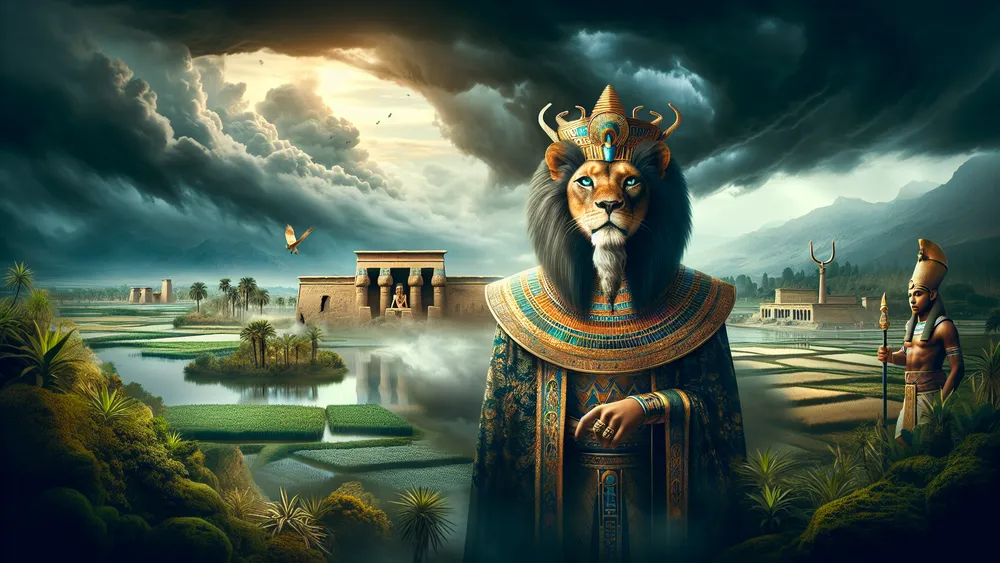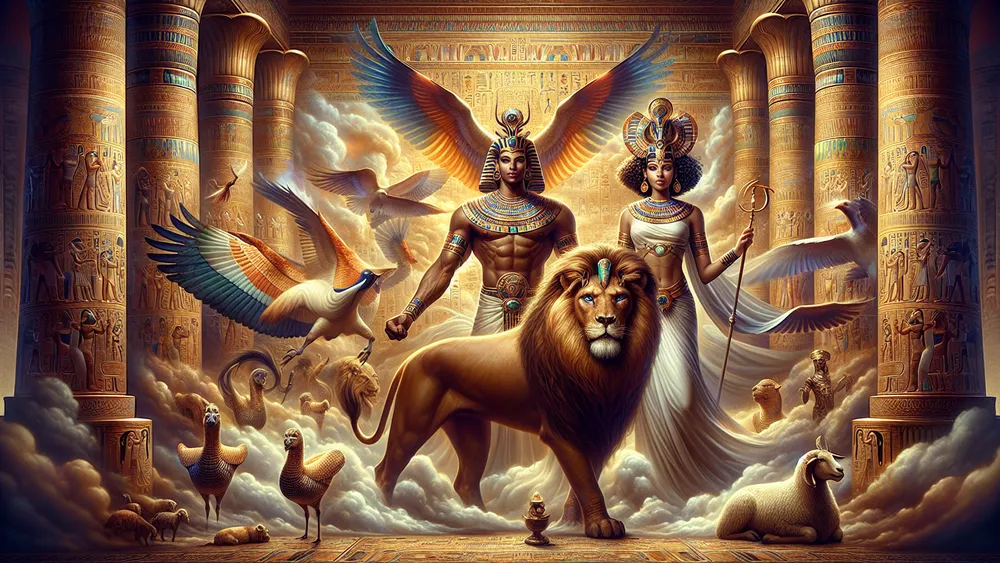Tefnut: Egyptian Goddess Of Moisture And Rain
Tefnut, a key figure in ancient Egyptian mythology, stands out as the goddess of moisture and rain. Her story ties closely with nature and the everyday lives of the ancient Egyptians, showing their deep bond with the environment. In this blog post, we dive into Tefnut’s mythology, her roles and powers, her relationships with other gods, and her impact on ancient Egyptian society.
Key Points:
- Tefnut is the Egyptian goddess of moisture and rain.
- She is the daughter of Ra and twin sister of Shu, the god of air.
- Tefnut’s role in Egyptian mythology involves maintaining cosmic balance and fertility.
- People worshipped Tefnut for agricultural success and balanced weather.
- Tefnut’s powers include controlling moisture, rain, and fertility.
- Her weaknesses involve vulnerability to separation and its impact on natural balance.
- Tefnut’s legacy transcends ancient Egypt, influencing later cultures and modern interpretations.
We want to give you a full picture of Tefnut’s importance and legacy, both in history and today. So, let’s explore these aspects and see what makes Tefnut so special.
Understanding Tefnut: The Egyptian Goddess
To really get what Tefnut’s all about in ancient Egyptian mythology, we need to look at who she is and why she matters. So, let’s dive into her story and see why the ancient Egyptians held her in such high regard.
Who Is Tefnut?
Tefnut is a big name in ancient Egyptian mythology. She’s the goddess of moisture and rain. You often see her depicted as a lioness or a woman with a lioness head, which shows her fierce and protective side. She’s one of the earliest deities, and she plays a huge role in the creation story.
Tefnut is the daughter of the sun god Ra (or Atum) and has a twin brother named Shu, who is the god of air. Together, they keep the balance of the cosmos. Her importance goes beyond just myths. People venerated her for controlling essential natural elements like moisture and rain, which are super important for agriculture and life in Egypt’s dry climate.
They performed rituals and made offerings to her to ensure enough rainfall and to keep nature in harmony. This shows how much she influenced both the environment and daily life.
- Depictions: Often shown as a lioness or a woman with a lioness head.
- Parentage: Daughter of Ra (or Atum).
- Siblings: Twin sister of Shu, the god of air.
- Role in Creation Myth: Helped maintain cosmic balance.
- Cultural Practices: Rituals and offerings to ensure rainfall and agricultural success.
Tefnut, the goddess of moisture and rain in ancient Egyptian mythology, played a crucial role in maintaining cosmic balance and influencing agricultural practices through rituals and offerings for rainfall and harmony in nature.
The Mythology Of Tefnut
Tefnut’s story kicks off with her creation by Ra, the sun god and creator deity in ancient Egyptian mythology. Ra creates Tefnut and her twin brother Shu by spitting them out, which symbolizes the emergence of moisture and air. Pretty interesting, right? Tefnut plays a crucial role in the creation myth. She and Shu help establish the order of the cosmos by separating the sky (Nut) from the earth (Geb).
This act is essential for creating a habitable world. In various myths, Tefnut gets involved in significant events and interacts with other gods. For instance, one story tells of her temporary departure from Egypt, leading to a period of drought and chaos until her return restores balance and fertility.
Her interactions with other deities, like her children Geb and Nut, further emphasize her importance in maintaining cosmic harmony and natural cycles.
- Creation by Ra: Tefnut and Shu are created by Ra through spitting.
- Cosmic Balance: They help separate the sky (Nut) from the earth (Geb).
- Period of Drought: Her departure causes drought and chaos.
- Restoration of Balance: Her return brings back fertility and order.
The Role And Importance Of Tefnut In Ancient Egypt
Tefnut plays a big role in ancient Egyptian life. She’s the goddess of moisture and rain, which means she has a direct impact on farming and the weather. People rely on her to keep the land fertile, so crops can grow and everyone can eat. They believe she controls the balance of nature, making her super important in their world.

To keep her happy, they perform various worship practices like rituals, prayers, and offerings. Temples and special places dedicated to Tefnut pop up all over, where priests hold ceremonies to honor her and ask for rain and good harvests. These practices show just how much she matters, not only in nature but also in their everyday lives.
| Aspect | Details |
|---|---|
| Agricultural Influence | Ensures fertility of the land, crucial for crop growth. |
| Weather Control | Believed to maintain balance in nature through control over moisture and rain. |
| Worship Practices | Includes rituals, prayers, and offerings to gain her favor. |
| Temples and Cult Centers | Established sites where priests conduct ceremonies to honor Tefnut. |
The Powers Of Tefnut
So, now that we know how Tefnut fits into nature and society, let’s check out her special powers. What makes her such a big deal in Egyptian mythology? Let’s dive in and find out!
What Is Tefnut The Goddess Of?
Tefnut is mainly the goddess of moisture, rain, and water in ancient Egyptian mythology. She looks after all kinds of moisture, like rain, dew, and mist. This makes her super important for keeping the land fertile. But that’s not all. Tefnut also deals with heat and dryness, showing she controls both wet and dry elements. This balance is key for life and farming.
She makes sure the climate stays just right, with enough water and heat to keep everything growing.
- Moisture: Includes rain, dew, and mist.
- Water: Essential for irrigation and drinking.
- Heat: Represents the sun’s warmth necessary for growth.
- Dryness: Balances moisture to prevent over-saturation.
What Are Tefnut’s Powers?
Tefnut’s powers are all about nature, especially when it comes to weather and fertility. She’s the goddess of moisture and rain, so she controls the weather, making sure the land gets enough rain for crops. This means she keeps things balanced between wet and dry, which is super important for farming. But that’s not all. Tefnut also helps with fertility and growth.
Her presence makes the soil more fertile, which is great for planting and harvesting. So, she plays a big role in keeping life going and making sure there’s plenty of food.
- Weather Control: Ensures balanced rainfall and prevents droughts.
- Fertility Enhancement: Improves soil quality for better crop yields.
- Growth Promotion: Supports the overall health of plants and vegetation.
Tefnut’s powers involve weather control for balanced rainfall and fertility enhancement for improved crop yields and growth promotion for plant health.
The Weakness Of Tefnut
Tefnut’s powers are vast and influential, but she has her vulnerabilities too. Understanding these weaknesses gives us a fuller picture of her role in ancient Egyptian mythology.
Identifying Tefnut’s Weakness
In ancient Egyptian myths, Tefnut has some vulnerabilities that stand out. One story tells about her leaving Egypt for a while, which causes a terrible drought and chaos for both gods and humans. This story shows how important she is for keeping things balanced.
Another myth talks about her and her brother Shu, the god of air, being separated by their father Atum. This separation messes up the natural order. These tales make it clear that even though Tefnut is powerful, her strength depends a lot on her relationships with other gods and the natural world around her.

- Example of Vulnerability: The story of Tefnut leaving Egypt, causing drought.
- Impact on Role: Separation from Shu leading to natural imbalance.
- Interconnectedness: Dependence on relationships with other gods for maintaining order.
Tefnut’s Family And Relationships
So, we’ve looked at Tefnut’s weaknesses and how they shape her story. Now, let’s dive into her family ties and the important relationships she has with other gods in Egyptian mythology.
Meet Tefnut’s Family
Tefnut, a key figure in Egyptian mythology, belongs to a well-known divine family. She’s the daughter of Atum, the creator god, and has a twin brother named Shu, who’s the god of air. Together, they keep the balance of moisture and air in the world. Tefnut’s children are Geb, the earth god, and Nut, the sky goddess.

They play big roles in the creation story. Her relationships with other gods are full of important interactions and alliances. For example, she partners with Shu to maintain cosmic order. But there are also conflicts, like when Atum separates her from Shu, which messes up the balance of nature and shows how connected all their roles are.
- Atum: Creator god and father of Tefnut.
- Shu: Twin brother and god of air.
- Geb: Son and god of the earth.
- Nut: Daughter and goddess of the sky.
- Separation from Shu: A significant myth highlighting cosmic disruption.
Tefnut And Nut
Tefnut and Nut have a special bond in Egyptian mythology. Tefnut, the goddess of moisture, is Nut’s mother. Nut, on the other hand, is the sky goddess. Their relationship plays a big part in the creation story. Tefnut and Shu, the god of air, come together and have Nut and Geb.
Nut stretches over the earth, which is her brother Geb, and keeps him apart from the heavens. This separation keeps the cosmos balanced. You can see Tefnut’s impact on Nut in many myths where moisture and rain help Nut do her job of nurturing the earth. Their roles show how everything in nature connects in Egyptian mythology. Moisture from Tefnut lets Nut support life on earth.
- Nut’s daily journey: Nut swallows the sun each night and gives birth to it each morning.
- Tefnut’s role in fertility: Moisture from Tefnut is essential for Nut to nourish the earth.
- Cosmic balance: The separation of Nut and Geb by Shu and Tefnut maintains order in the universe.
- Myth of separation: Atum’s separation of Tefnut and Shu disrupts natural balance, affecting Nut and Geb.
The connection between Tefnut and Nut in Egyptian mythology is crucial for maintaining cosmic balance and supporting life on earth through moisture and fertility.
Tefnut And Geb
Tefnut, the goddess of moisture, and Geb, the god of the earth, share a special bond in Egyptian mythology. Geb is Tefnut’s son, and their relationship is key to keeping nature in balance. Her moisture helps Geb sustain life on earth, making sure everything grows. In many myths, this connection is vital.
One story tells how Shu and Tefnut separate Geb and Nut to keep cosmic order. This story shows how Tefnut’s influence reaches her children, affecting their roles in the pantheon. The link between Tefnut and Geb highlights how natural elements are connected in Egyptian myths. Moisture from Tefnut directly impacts the fertility and productivity of Geb.
- Geb’s role in creation: Geb lies beneath Nut, representing the earth.
- Tefnut’s influence on agriculture: Moisture from Tefnut is essential for crops to grow on Geb’s surface.
- Cosmic separation story: Shu and Tefnut’s separation of Geb and Nut maintains the balance of the universe.
- Depictions in art: Ancient Egyptian art often shows Geb with green skin, symbolizing vegetation, which is nurtured by Tefnut’s moisture.
Tefnut and Geb’s bond in Egyptian mythology is crucial for maintaining natural balance and sustaining life on earth through her moisture that directly impacts Geb’s fertility and productivity.
Tefnut In Modern Interpretations
Tefnut’s story doesn’t just stay in the past. It finds a place in today’s culture and thinking. Let’s dive into how her mythology shows up and is understood now.
Tefnut In Literature And Pop Culture
Tefnut, the Egyptian goddess of moisture and rain, pops up in all sorts of modern media. You see her in books, movies, and TV shows. In literature, she shows up in stories that dive into ancient Egyptian mythology. Think historical novels and fantasy series that love to borrow from those old myths. When it comes to movies and TV shows, Tefnut often appears in tales about ancient Egypt.
Her role? Influencing weather and fertility, of course. And let’s not forget art. Modern artists love to paint or sculpt her with symbols of water and rain, showing off her divine traits. These depictions keep her story alive and introduce her to folks who might not know much about ancient Egyptian mythology.
- Books: “The Kane Chronicles” by Rick Riordan.
- Movies: “Gods of Egypt” (2016).
- TV Shows: “Stargate SG-1” features Egyptian gods.
- Artistic Representations: Modern paintings and sculptures inspired by Egyptian deities.
The Modern Relevance Of Tefnut’s Mythology
Tefnut’s mythology still matters today because it teaches us about balance. Her stories show how important it is to keep things in check, like moisture and dryness. This idea fits well with today’s environmental movements that push for sustainable living and saving our planet’s resources. Plus, Tefnut’s control over weather and fertility connects with modern spiritual practices.

People now look to ancient gods like her for inspiration in rituals that honor nature. This reflects a growing interest in eco-spirituality and nature-based worship.
- Environmental Movements: Advocacy for sustainable practices.
- Eco-Spirituality: Modern rituals honoring natural elements.
- Nature-Based Worship: Practices inspired by ancient deities.
Tefnut’s mythology is relevant today for its lessons on balance and connection to environmental movements and modern spiritual practices.
Pantheon of All the Egyptian Mythology Gods
The Egyptian pantheon? It’s huge! There are so many gods and goddesses, each with their own special stories and roles. If you want to dive deeper, check out this list of all the Egyptian gods. It’s packed with details about the major deities and what they mean to ancient Egyptian culture.
FAQs
1. What Was Tefnut’s Greatest Weakness According To Ancient Myths?
Tefnut’s greatest weakness according to ancient myths was her vulnerability to separation from her twin brother Shu, which caused chaos and imbalance in the world.
2. How Did Tefnut’s Weakness Impact Her Role In The Egyptian Pantheon?
Tefnut’s weakness impacted her role in the Egyptian pantheon by occasionally diminishing her influence and causing conflicts with other deities.
3. Are There Any Modern Interpretations Of Tefnut’s Weakness?
Modern interpretations of Tefnut’s weakness often explore themes of balance and the duality of nature.
4. How Did The Ancient Egyptians View Tefnut’s Weakness?
The ancient Egyptians viewed Tefnut’s weakness as a reflection of the natural balance and duality inherent in their cosmology.







